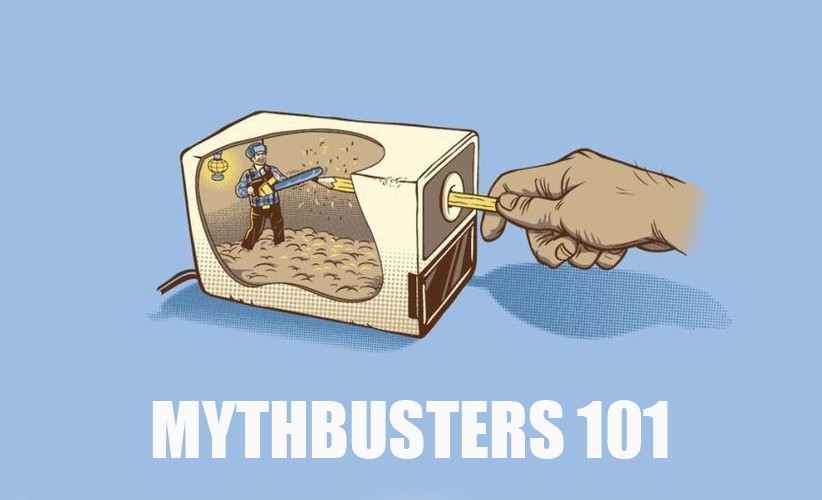5 InMail Myths Busted
You’ve probably been warned that you should wait 30 minutes after eating before you swim—but that’s a total myth. Think of all the extra swim time you could have enjoyed if you knew the truth!
Similarly, knowing the truth about InMails can help you be a better, more effective recruiter. InMails can be one of your best recruiting tools and you might be holding yourself back if you believe one the common misconceptions below.
That’s why we’re bursting bubbles busting myths about InMails: read on for revelations and actionable tips to improve your InMail response rates.
Myth #1: If a candidate rejects your InMail, you won’t be able to InMail them again
Truth: You can InMail someone even if they’ve rejected you before
This rumor has recently started making the rounds and it’s completely false. If a candidate rejects your InMail, you’re not blocked from sending them another one. In fact, you can InMail them again as soon as you want (although be conscious that too many messages may come off as spammy).
If a prospect rejects your InMail within 90 days, the only thing that does happen is that you get an InMail credit back to your account.
That’s because any InMail response within that timeframe—whether they’re “not interested” or want to hear more—will earn you an InMail credit.
Myth #2: Bulk InMails work just as well as ones sent individually
Truth: Personalized InMails get the highest response rates
If you can tell the difference between a spammy message sent en masse and one written just for you - so can your target candidates. In theory, sending InMails in bulk will obviously help you reach more people, but your response rate is bound to take a tumble.
It’s been debunked before, but this myth is alive and well—lots of InMails are still sent in bulk. If only they knew! Customized InMails are far more effective: acceptance rates for these InMails are 13% higher than average, and hiring rates are 43% (!!!) above average.
On the flipside, InMails sent in batches of 11 to 25 recipients get a response rate that’s 15% below average, and a hiring rate that’s 37% lower. Personalization pays off.
Myth #3: You should send your InMail on just the right day, at just the right time
Truth: Timing doesn’t really affect response rates
A recent in-depth analysis shows that there’s pretty much no effect when it comes to finding the best time to send an InMail.
Most InMails are sent between 8am and 6pm on weekdays, but they don’t have to be. Whether you send an InMail at 9am on a Tuesday or 9pm on a Saturday won’t make much of a difference: the day and time-of-day won’t impact your response rates significantly.
Myth #4: Longer, detailed InMails do better
Truth: Concise InMails are more effective
You might think candidates want to know anything and everything about the position, your company, and your culture, but when it comes to your first InMail, you should leave a little to the imagination.
InMails over 200 words get an acceptance rate that’s 13% worse than average, while InMails under 100 words do 13% better than average. That might be because a whopping 75% of InMails are opened on a smartphone.
No one wants to read an essay on their phone. Imagine you were on an online dating platform and you got a seven-paragraph message from a suitor. It’s not just TMI, it comes off as a little desperate.
This surprisingly applies to InMail subjects lines too: one- and two-word subject lines do 13% better than average in terms of acceptance rates, while subject lines with 10 words or more get accepted at a rate 19% below average. (You don’t need to always come up with a one-word subject, but you probably should limit to six words or fewer.)
Myth #5: InMail response rates are dropping
Truth: InMail response rates are at all time highs.
In reality, candidates have never been so responsive. InMail response rates hit an all-time high in June, and are up 45% year-over-year.
Some might try to rebut this with a common variation on the same myth, like, “Yeah, but software engineers never respond.” Nope: InMail response rates have increased across all segments.
That’s thanks to a series behind-the-scene algorithmic improvements that help recruiters find candidates likely to respond and make unread InMails easier to see.
Now that you know the truth, you can start sending InMails like an expert. Just remember -- the primary goal of InMails is to get the candidate excited about the opportunity! Don’t expect to close a hire with one InMail.
Remember the ABC of InMails: Actionable, Brief, Customized.
To receive blog posts like this one straight in your inbox, subscribe to the blog newsletter.
Topics: LinkedIn product tips
Related articles



